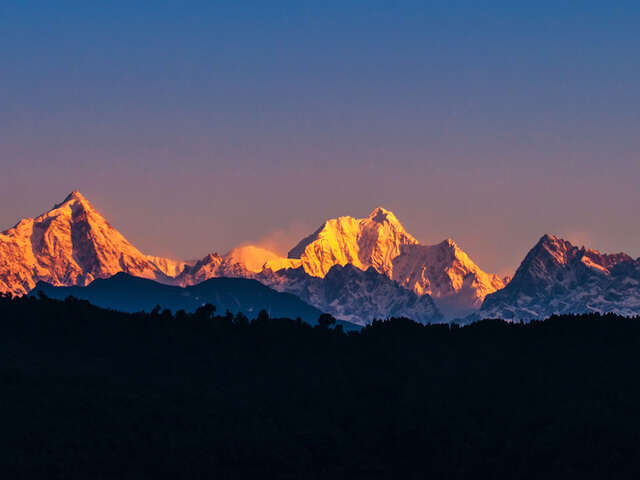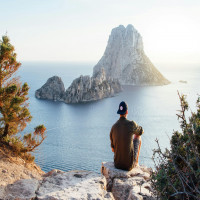Kanchenjunga: The Majestic Peak of the Himalayas

Strong 8k brings an ultra-HD IPTV experience to your living room and your pocket.
Kanchenjunga, often referred to as the "Five Treasures of Snow," is the third-highest mountain in the world and one of the most revered peaks in the Himalayas. Located on the border between Nepal and the Indian state of Sikkim, Kanchenjunga stands tall at 8,586 meters (28,169 feet) above sea level. Its majestic presence has captivated the imagination of explorers, trekkers, and mountaineers for centuries. The mountain is not only a geographical marvel but also a cultural symbol for the people of the region. This article explores the history, significance, and the wonders that Kanchenjunga offers to those who visit it.
The Significance of Kanchenjunga
The name "Kanchenjunga" is derived from the Tibetan words "Kanchen" meaning "treasure" and "Junga" meaning "snow" or "snowy." The peak is believed to be a sacred mountain by the local Sikkimese people, and it holds great religious importance for both Hindus and Buddhists. According to local legends, the mountain is considered the abode of the gods, and it is often seen as a guardian of the region. The Kanchenjunga massif consists of five major peaks, each of which represents a different treasure of the snow.
The five peaks are:
Kanchenjunga Main (8,586 m) – The highest of the peaks.
Kanchenjunga West (8,505 m).
Kanchenjunga Central (8,482 m).
Kanchenjunga South (8,494 m).
Kanchenjunga North (7,350 m).
Kanchenjunga is not just an imposing figure in the landscape; it also plays a crucial role in the culture and traditions of the region. For the people of Sikkim, Kanchenjunga is a deity and is revered with offerings, prayers, and festivals. The local Sherpa people, who reside in the foothills of the mountain, hold Kanchenjunga in the highest esteem, and many trekkers seek blessings from the mountain before embarking on their journey.
The History of Kanchenjunga
Kanchenjunga remained largely unexplored until the early 19th century. In 1849, the British surveyor Andrew Waugh declared it the highest peak in the world, before Mount Everest was officially recognized as the world's tallest peak in 1852. However, it wasn’t until 1856 that Kanchenjunga was officially mapped by the British, and it became known to the world. In 1930, a team from Britain attempted to summit the mountain, but it was only in 1955 that the first successful ascent was made by an Indian expedition led by Nawang Sering, with the help of a British team.
While it may not be as popular for climbing as Mount Everest or K2, Kanchenjunga has a reputation for being one of the most difficult and dangerous mountains to summit due to its steep slopes, unpredictable weather, and difficult terrain. The mountain has claimed many lives over the years, and its remote location adds to the challenge.
The Kanchenjunga Trek
For trekkers, Kanchenjunga offers some of the most spectacular trekking routes in the world. There are several trekking routes that allow visitors to explore the surrounding region, offering magnificent views of the mountain and its surrounding valleys, glaciers, and forests. The most popular trekking routes are in the Indian state of Sikkim, which is accessible from the town of Pelling, and the trekking route from Nepal’s Taplejung district.
Some of the notable trekking routes around Kanchenjunga include:
Kanchenjunga Base Camp Trek (India): The Kanchenjunga Base Camp trek is one of the most sought-after treks for adventurers in Sikkim. The trek takes you to the south base camp of Kanchenjunga, passing through lush rhododendron forests, remote villages, and alpine meadows. The views of the mountain from the base camp are unparalleled, making it a truly unforgettable experience. Along the way, trekkers also pass by small Buddhist monasteries and come across diverse flora and fauna.
The trek typically takes around 10-12 days and offers various camping sites. The base camp is located at an altitude of around 5,143 meters, so trekkers should be prepared for high-altitude conditions and carry the necessary equipment to cope with the cold weather.
Kanchenjunga North Trek (Nepal): The North Base Camp trek is another popular route for those looking to explore Kanchenjunga from Nepal. This trek takes you through a mix of lowland forests, traditional Sherpa villages, and remote alpine landscapes. Along the way, trekkers pass through the Kanchenjunga Conservation Area, a region rich in biodiversity. The trek culminates at the Kanchenjunga North Base Camp, offering spectacular views of the mountain.
Trekking from the Singalila Ridge (India-Nepal border): For those who want to experience Kanchenjunga from a different perspective, trekking along the Singalila Ridge offers incredible views of the mountain range. This route lies along the border between India and Nepal and offers panoramic vistas of the entire Kanchenjunga range. The ridge is also a great place for birdwatching and nature photography, as it is home to several species of birds and plants.
These trekking routes provide adventurers with the opportunity to witness the diverse ecosystems around Kanchenjunga, ranging from subtropical forests at lower altitudes to alpine meadows and glaciers as one ascends higher.
Flora and Fauna Around Kanchenjunga
Kanchenjunga is not only famous for its stunning peaks but also for its incredible biodiversity. The Kanchenjunga Conservation Area, located in Nepal, is home to a wide variety of plants and animals. The region’s ecosystems range from subtropical forests at lower altitudes to alpine meadows and glaciers at higher altitudes.
Some of the notable wildlife species found in the region include:
Red Panda: A shy and endangered species that is native to the eastern Himalayas, including the Kanchenjunga area.
Snow Leopard: A rare and elusive big cat that lives at higher altitudes.
Himalayan Tahr: A large herbivorous mammal found in the mountain ranges of the Himalayas.
Wild Yak: Often found in the higher reaches of the Kanchenjunga region.
The diverse flora of the region includes rhododendrons, orchids, alpine flowers, and a wide variety of medicinal plants. The pristine beauty of the landscape and the richness of its wildlife make Kanchenjunga an attractive destination for nature lovers, wildlife enthusiasts, and photographers.
Cultural Significance of Kanchenjunga
Kanchenjunga holds great cultural significance for the local people in both Nepal and India. For the Sikkimese people, Kanchenjunga is a revered mountain, and many festivals are dedicated to it. The Lepcha and Bhutia communities, who are indigenous to Sikkim, consider Kanchenjunga to be the home of their gods. The peak is also a central figure in many of the region’s legends and folklore.
The local monasteries, especially in Sikkim, hold prayers and rituals dedicated to Kanchenjunga, seeking blessings for the prosperity and safety of the community. Pilgrims from all over the region visit these monasteries and temples to honor the mountain and seek protection.
Conclusion
Kanchenjunga is not just a towering mountain in the Himalayas; it is a symbol of strength, beauty, and spiritual significance. Whether you are an avid mountaineer aiming for the summit or a trekker exploring the surrounding valleys, Kanchenjunga offers experiences that are truly unforgettable. Its breathtaking beauty, challenging terrain, and rich cultural significance make it a destination that continues to captivate the hearts of adventurers and spiritual seekers alike. Whether you’re trekking along its foothills, admiring its snow-covered peaks, or learning about the legends surrounding it, Kanchenjunga leaves an indelible mark on all who visit.
Note: IndiBlogHub features both user-submitted and editorial content. We do not verify third-party contributions. Read our Disclaimer and Privacy Policyfor details.


